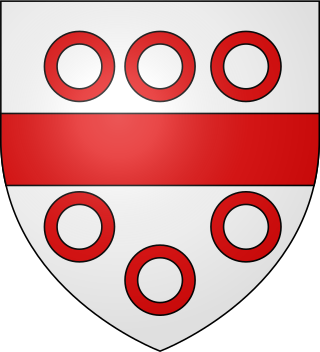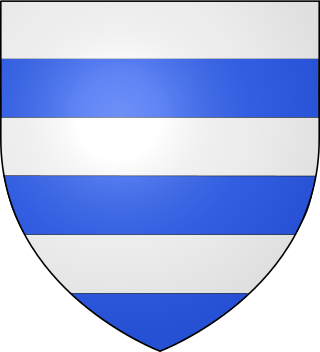
Marquess of Aberdeen and Temair, in the County of Aberdeen, in the County of Meath and in the County of Argyll, is a title in the Peerage of the United Kingdom. It was created on 4 January 1916 for John Hamilton-Gordon, 7th Earl of Aberdeen.

Duke of Kent is a title that has been created several times in the peerages of Great Britain and the United Kingdom, most recently as a royal dukedom for the fourth son of King George V. Since 1942, the title has been held by Prince Edward, Queen Elizabeth II's cousin.

Earl Grey is a title in the peerage of the United Kingdom. It was created in 1806 for General Charles Grey, 1st Baron Grey. In 1801, he was given the title Baron Grey of Howick in the County of Northumberland, and in 1806 he was created Viscount Howick in the County of Northumberland, at the same time as he was given the earldom. A member of the prominent Grey family of Northumberland, Earl Grey was the third son of Sir Henry Grey, 1st Baronet of Howick.

Marquess of Cholmondeley is a title in the Peerage of the United Kingdom. It was created in 1815 for George Cholmondeley, 4th Earl of Cholmondeley.

Earl of Guilford is a title that has been created three times in history. The title was created for the first time in the Peerage of England in 1660 for Elizabeth Boyle. She was a daughter of William Feilding, 1st Earl of Denbigh, and the widow of Lewis Boyle, 1st Viscount Boyle of Kinalmeaky. The title was for life only and became extinct on her death in 1667. The title was created for a second time in the Peerage of England in 1674 for John Maitland, 1st Duke of Lauderdale. For more information on this creation, see the article on him as well as the Earl of Lauderdale.

Earl of Hardwicke is a title in the Peerage of Great Britain. It was created in 1754 for Philip Yorke, 1st Baron Hardwicke, Lord High Chancellor of Great Britain from 1737 to 1756. He had already been created Baron Hardwicke, of Hardwicke in the County of Gloucestershire, in 1733, and was made Viscount Royston at the same time as he was given the earldom. These titles were also in the Peerage of Great Britain.

Baron Lucas is a title that has been created twice in the Peerage of England. The second creation is extant and is currently held with the title Lord Dingwall in the Peerage of Scotland.

Earl of Egmont was a title in the Peerage of Ireland, created in 1733 for John Perceval, 1st Viscount Perceval. It became extinct with the death of the twelfth earl in 2011.

Earl Erne, of Crom Castle in the County of Fermanagh, is a title in the Peerage of Ireland. It was created in 1789 for John Creighton, 2nd Baron Erne, who had earlier represented Lifford in the Irish House of Commons. He had already been made Viscount Erne, of Crom Castle in the County of Fermanagh, in 1781, also in the Peerage of Ireland, and sat from 1800 to 1828 as an Irish Representative Peer in the British House of Lords. The title of Baron Erne, of Crom Castle in the County of Fermanagh, was created in the Peerage of Ireland in 1768 for his father Abraham Creighton. The Earl was succeeded by his eldest son, the second Earl. On his death the titles passed to his nephew, the third Earl. He was an Irish Representative Peer from 1845 to 1885 and also served as Lord Lieutenant of County Fermanagh during the same period. In 1876 he was created Baron Fermanagh, of Lisnaskea in the County of Fermanagh, in the Peerage of the United Kingdom. This was to allow the Earls to sit in the House of Lords by right, rather than having to stand for election as Representative Peers. An earlier title of Baroness Fermanagh in the Peerage of Ireland was created for Mary Verney on 13 June 1792, but became extinct on her death on 15 November 1810.

Earl Temple of Stowe, in the County of Buckingham, is a title in the Peerage of the United Kingdom. It was created in 1822 for Richard Temple-Nugent-Brydges-Chandos-Grenville, 2nd Marquess of Buckingham, who was created Marquess of Chandos and Duke of Buckingham and Chandos at the same time. In contrast to the Marquessate and Dukedom, which were created with remainder to the heirs male of his body only, the Earldom was created with remainder to (1) the heirs male of his body, failing which to (2) the heirs male of his deceased great-grandmother the 1st Countess Temple, failing which to (3) his granddaughter Lady Anna Grenville and the heirs male of her body, and then to possible younger daughters of Lord Temple and the heirs male of their bodies.

Earl of Morley, of Morley in the County of Devon, is a title in the Peerage of the United Kingdom. It was created in 1815 for John Parker, 2nd Baron Boringdon. At the same time he was created Viscount Boringdon, of North Molton in the County of Devon, which is used as a courtesy title by the heir apparent to the earldom. It does not seem to have any connection with Baron Morley of Morley in Norfolk, held by another Parker family in the 16th century.

Earl of Strafford is a title that has been created three times in English and British history.

James Albert Edward Hamilton, 3rd Duke of Abercorn, styled Marquess of Hamilton between 1885 and 1913, was a British peer and Unionist politician. He was the first Governor of Northern Ireland, a post he held between 1922 and 1945. He was a great-grandfather of Diana, Princess of Wales.

Earl of Stamford was a title in the Peerage of England. It was created in 1628 for Henry Grey, 2nd Baron Grey of Groby. This Grey family descended through Lord John Grey, of Pirgo, Essex, younger son of Thomas Grey, 2nd Marquess of Dorset, and younger brother of Henry Grey, 1st Duke of Suffolk ; Suffolk was executed for treason in 1554 forfeiting his titles.

Charles Robert Spencer, 6th Earl Spencer,, styled The Honourable Charles Spencer until 1905 and known as Viscount Althorp between 1905 and 1910, was a British courtier and Liberal politician from the Spencer family. An MP from 1880 to 1895 and again from 1900 to 1905, he served as Vice-Chamberlain of the Household from 1892 to 1895. Raised to peerage as Viscount Althorp in 1905, he was Lord Chamberlain from 1905 to 1912 in the Liberal administrations headed by Sir Henry Campbell-Bannerman and H. H. Asquith. In 1910, he succeeded his half-brother as Earl Spencer. He was married to Margaret Baring, a member of the Baring family.
Richard Fleming George Charles Grey, 6th Earl Grey was a British hereditary peer.

Lieutenant-General Charles Butler, 1st Earl of Arran, de jure3rd Duke of Ormonde (1671–1758) was an Anglo-Irish peer. His uncle Richard was the 1st Earl of Arran of the first creation. The titles were re-created for Charles in 1693. His elder brother, the 2nd Duke of Ormonde, was attainted during the Jacobite rising of 1715, but in 1721 Arran was allowed to buy the estate back. At the death of the 2nd Duke, he succeeded as de jure 3rd Duke of Ormonde in the Irish peerage but did not claim the title.

There have been three baronetcies created for members of the Grey family, one in the Baronetage of England, one in the Baronetage of Great Britain and one in the Baronetage of the United Kingdom. Two of the creations are extant as of 2007.
Thomas Lyon-Bowes, 11th Earl of Strathmore and Kinghorne was a Scottish nobleman and peer. He was the third son of John Bowes, 9th Earl of Strathmore and Kinghorne, and Mary Bowes, Countess of Strathmore and Kinghorne. His mother was the author of the verse drama, "The Siege of Jerusalem" (1769). He was the great-great-grandfather of Queen Elizabeth The Queen Mother.

The House of Grey is an ancient English noble family from Creully in Normandy. The founder of the House of Grey was Anchetil de Greye, a Norman chevalier and vassal of William FitzOsbern, 1st Earl of Hereford, one of the few proven companions of William the Conqueror known to have fought at the Battle of Hastings in 1066.











